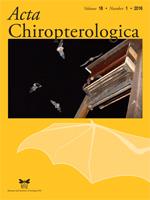Molecular techniques allow amplification of a mitochondrial barcoding gene, cytochrome c oxidase (COI), of prey DNA in bat fecal material that can be used to identify insect species. Most studies designed to use a molecular approach for dietary studies of bats suggest that fecal material should be collected within one week of deposit to prevent environmental degradation or contamination. However, Ozark big-eared bats (Corynorhinus townsendii ingens) are highly susceptible to human disturbance. The purpose of this study was to performing a molecular dietary analysis of Ozark big-eared bats. Our study detected 40 species representing two orders (Diptera and Lepidoptera) and 11 families of insects and thus, providing new information regarding dietary habits of Ozark big-eared bats.
How to translate text using browser tools
1 June 2016
Molecular Dietary Analysis of the Endangered Ozark Big-Eared Bat (Corynorhinus townsendii ingens)
Ronald A. Van Den Bussche,
Dana N. Lee,
Megan E. Judkins,
Jenny E. Dyer,
Denise M. Thompson,
Richard C. Stark,
William L. Puckette,
Brian Fuller
ACCESS THE FULL ARTICLE

Acta Chiropterologica
Vol. 18 • No. 1
June 2016
Vol. 18 • No. 1
June 2016
cytochrome c oxidase
diet
molecular analysis
Ozark big-eared bat




